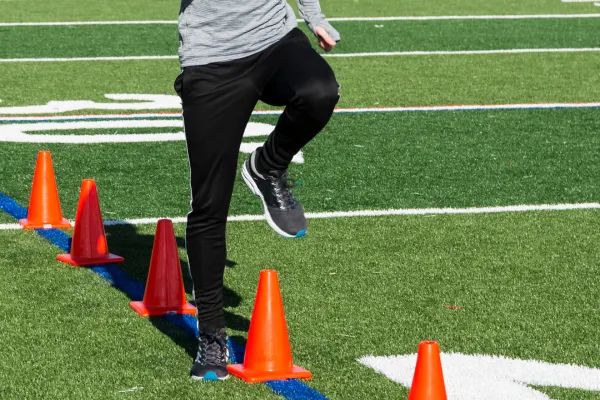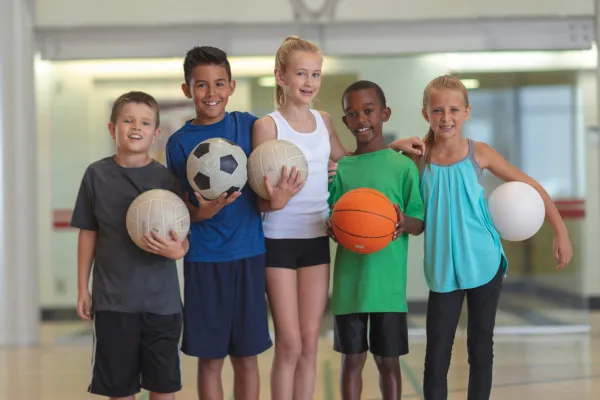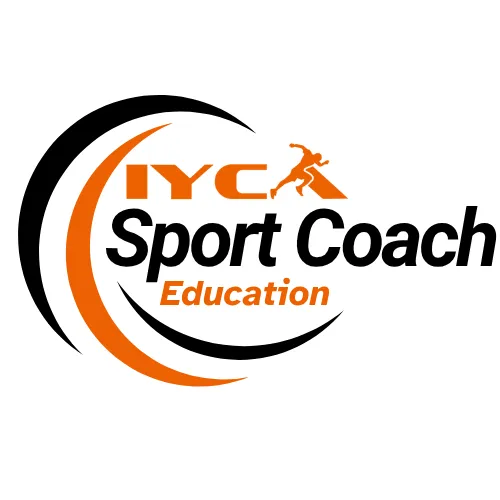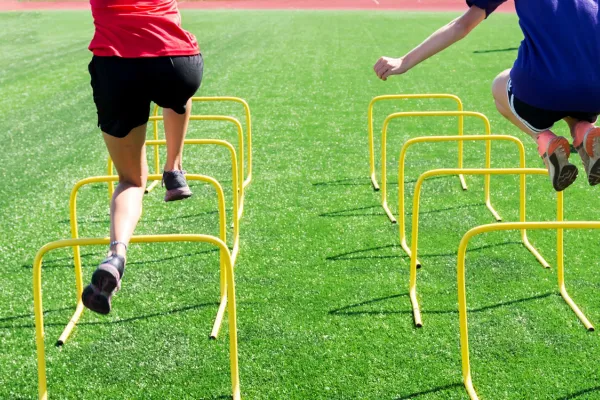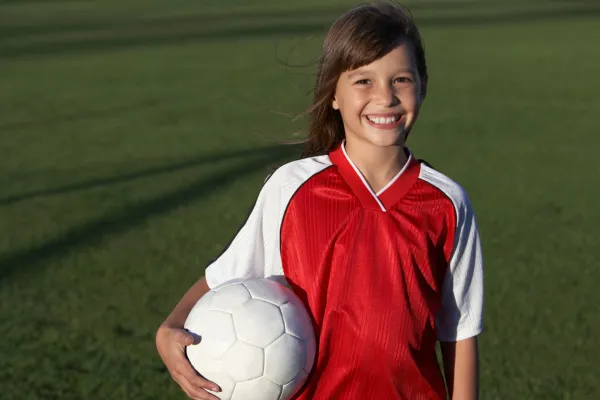
Ignite Her Potential: The 4 C’s of Purposeful Coaching
Written by Julie Hatfield-Still, Brand Executive for the International Youth Coaching Association and President of Beyond The Game Alliance
At the IYCA, we recognize that purposeful coaching is not just about developing athletes’ skills—it’s about shaping their confidence, identity, and resilience for life beyond the game.
When it comes to coaching girls, success is not accidental. It comes from an intentional approach that addresses the needs of the whole athlete. We call this framework The 4 C’s of Purposeful Coaching: Connection, Communication, Clarity, and Consistency.
These four pillars are grounded in both science and practice, and they can be applied by any coach today.
Pillar 1. Connection: The Foundation of Trust
Connection is not optional—it’s essential. Girls often decide whether to remain in sport based on whether they feel connected to their coach and teammates. Studies confirm that belonging is one of the strongest predictors of motivation and long-term participation.
Here is one strategy you can start applying today, I call it Name. Connect. Coach.
The Framework: Name, Connect to Their Effort, Coach Them Forward.
Name: Using an athlete’s name during feedback personalizes the interaction and conveys respect. It signals, “I see you.”
Connect to Their Effort: Instead of praising outcomes (“Great shot”), emphasize the behaviors that led there (“I noticed how you followed through after the pass—that hustle made a difference”). This reinforces a growth mindset and emphasizes that effort is within their control.
Coach Them Forward: After recognition, offer one clear, actionable cue for improvement. This shows belief in their potential and gives direction without overwhelming.
Why It Matters: Girls who feel unseen or reduced to their performance are more likely to disengage. By contrast, athletes who feel known, valued, and guided are more resilient in the face of setbacks. Don’t believe me…try it out today!
How to Apply Today: In your next practice, make it your mission to call each athlete by name, affirm one piece of effort, and give a forward-focused cue. Over time, these micro-moments foster trust and a sense of belonging.
Pillar 2. Communication: The Multiple Channels of Coaching
Communication goes far beyond the words you say. Girls process tone, body language, and non-verbal cues at a heightened level compared to boys, according to research in adolescent psychology. They don’t just hear what you say—they interpret how you say it and whether your actions align with your message.
Listen, communication is the lifeline of purposeful coaching. It’s not just what you say during practice & sessions—it’s how you interact with everyone connected to an athlete’s journey. For girls in particular, the quality and tone of communication directly influence their confidence, buy-in, and long-term commitment to sport.
Girls often respond not only to how you coach them, but also to how you coach others. They are constantly observing: How do you treat a struggling teammate? How do you talk to referees? How do you engage with their parents? Your communication becomes the blueprint for what respect, care, and leadership look like.
When communication breaks down in one area, it doesn’t just create a gap—it creates stress that girls carry with them.
The Four Channels of Coaching Communication
Coach to Athlete
This is the most obvious channel, but often misunderstood. Girls don’t just want to be told what to do—they want to understand why and to feel the message is delivered with care. Research shows that feedback framed in terms of growth (“Here’s the next step”) instead of failure keeps girls engaged and motivated.Coach to Parent
Parents are not bystanders; they are part of an athlete’s support system. When a coach shuts parents out, it creates confusion, mistrust, and pressure that trickles down to the athlete. Girls often feel caught in the middle, pulled between loyalty to their coach and loyalty to their family.
When parents are excluded, girls carry the weight of filling that gap. Open, respectful communication with parents relieves athletes of unnecessary stress and creates alignment across the whole support system.Coach to Staff/Other Coaches
A unified coaching staff is critical. If your team of coaches delivers mixed messages, athletes—especially girls—pick up on the inconsistencies and often internalize them as personal failures. For example, if one coach praises discipline but another tolerates laziness, girls wonder: Am I doing this right, or not? Clear communication within the coaching staff ensures that every message reinforces the same standards and values.Coach to Care Team
Today’s female athletes may also have a care team: athletic trainers, strength coaches, sports psychologists, nutritionists, or physical therapists (to name a few). If a coach fails to communicate with these professionals, athletes receive conflicting advice. A trainer may say, “Take it easy on your ankle,” while the coach demands, “Push through.” Girls notice the disconnect, and it can lead to confusion, injury risk, and a sense that no one is fully looking out for them.
When coaches collaborate with care teams, it shows girls that their well-being is the top priority—not just their performance.
Why These Channels Matter for Girls
Girls are relational learners. They don’t separate what’s happening on the field from what’s happening in the web of relationships around them. When communication across all channels is strong, girls feel supported, safe, and free to give their best effort. When communication is fractured, they feel tension, uncertainty, and pressure that erodes confidence.
How to Apply Today:
Communicate clearly and constructively with athletes, making space for questions and dialogue.
Proactively set expectations with parents—what their role is, how you’ll communicate, and how they can best support their daughter.
Align with your staff before practices and games, ensuring consistent language and shared priorities.
Stay in contact with the care team, showing athletes that their health and development are truly collaborative.
Communication is not a one-way street. It is a web of interconnected relationships—and girls are at the center. How you manage those channels determines whether they feel supported or stranded.
Next, let’s talk about the different layers of communication a coach must be aware of:
The Four Important Layers of Communication:
Instructional: This is the technical and tactical information—what to do and how to do it. Specificity is key. Instead of “pay attention,” use clear directives like, “Shoulders square, eyes up, plant your feet.” Clarity here reduces confusion and increases learning.
Emotional: Delivery matters as much as content. Neuroscience shows that when feedback is delivered harshly, the brain shifts into threat mode, shutting down higher-level learning. Girls in particular respond best when correction is paired with encouragement. For example, “You’re on the right track—let’s adjust your timing and try again.” Remember, reward effort before correcting errors.
Relational: This is the sense that you care about them as individuals. Do you ask about their day outside of sport? Do you know what matters to them? Relational communication fuels buy-in and loyalty.
Modeling: Actions communicate more than lectures. If you ask for composure, do you model it when referees make a tough call? If you ask for respect, do you demonstrate it in how you speak to every player, starter or bench? Modeling teaches more than instruction ever could.
How to Apply Today: Before each practice, set an intention for how you’ll use each channel. For example: Instructional (clear technical focus), Emotional (steady and constructive tone), Relational (connect with two athletes off the field), Modeling (show calm under pressure).
To summarize this pillar succinctly, speak with clarity and care to athletes. Set expectations with parents early. Align messages with your staff. Collaborate with the care team. Intentionally plan how you’ll use each layer—what you’ll teach, how you’ll deliver it, how you’ll connect, and how you’ll model behaviors.
Pillar 3. Clarity: Reducing Anxiety, Building Confidence
Ambiguity is a silent performance killer. Girls often thrive when they understand expectations and feel confident in their role. When those are unclear, anxiety increases and performance suffers.
Research from the Women’s Sports Foundation highlights that girls are more likely to drop out of sport when expectations are vague or when they feel uncertain about how to succeed. Clarity reduces stress, strengthens confidence, and builds commitment.
Areas Where Clarity is Critical:
Goals: Define what the team is working toward in each session and across the season. Specific goals transform practice from going through the motions to pursuing a purpose.
Roles: Every athlete should know where they fit—starter, reserve, leader, supporter—and how their contribution matters. Without clarity, athletes often compare themselves to others and undervalue their impact.
Expectations: Lay out what behaviors, attitudes, and standards you require. For example: punctuality, hustle, honesty, and communication. Consistency in these standards prevents conflict and confusion.
Explanations: Girls benefit when they understand the “why” behind instructions. “We run this drill to improve decision-making under pressure” gives meaning to the task.
How to Apply Today: Start and finish practice or sessions with clarity. Start with a focus circle to share what they can expect for the day, and if there is a specific focus. Ask athletes why it matters or how it will help them so they have personal buy-in. End practice with a clarity check. Ask athletes, “What was our focus today? What did we learn? What do we need to work on?” This not only reinforces learning but also empowers athletes to take ownership.
Pillar 4. Consistency: The Anchor of Stability
Girls need stability in order to thrive. When coaches are unpredictable—encouraging one day, volatile the next—it creates uncertainty and undermines trust. Consistency does not mean being emotionless or rigid; it means being steady in your values, expectations, and demeanor.
The Science Behind Consistency:
Neuroscience: Predictability reduces cognitive load. When athletes know what to expect from their coach, they can direct mental energy toward learning and performance instead of bracing for emotional swings.
Trust: Trust is built on reliability. Athletes need to know you’ll respond fairly and consistently, no matter the outcome of a game.
Culture: Teams mirror their leaders. Consistent leadership produces a consistent culture—one where athletes know what’s acceptable and what isn’t.
How to Apply Today: Evaluate your coaching presence. Would your athletes say you show up the same way, regardless of the scoreboard or your personal stress? Commit to being the anchor. Your steadiness allows athletes to take risks, push themselves, and recover from mistakes without fear of unpredictable reactions.
The Final Whistle
Purposeful coaching is not about being perfect—it’s about being intentional. Connection, Communication, Clarity, and Consistency are not abstract ideals; they are daily practices that shape whether girls feel empowered to stay in sport, grow as athletes, and develop as leaders.
When coaches embrace these four C’s, they create an environment where girls are not just trained, but truly coached—coached in a way that fosters belonging, confidence, and resilience.
That is purposeful coaching. That is the kind of coaching that changes lives.
It’s time to raise the standard.
Check out the deep dive
Coach Julie Hatfield-Still

About the Author:
Julie is an Author, CEO and Coach. She is the Brand Executive at the IYCA and the President & Founder of the Non-Profit Beyond The Game Alliance, which offers a full suite of workshops and support for teams and individual athletes. In addition to her work as a business consultant and coach of coaches, leaders, and entrepreneurs.
Julie is a Speed Development Specialist and Inner-Game Coach at the college, high school and youth levels.
Visit Julie’s Author Page
______________________________________________________________
Ready to Lead with Confidence, Not Guesswork?
At the IYCA, we believe that coaching is a profession of growth—and high-performing coaches are built on consistent habits, not just good intentions. That’s why we provide practical, athlete-centered education to help coaches at every level develop the skills, systems, and confidence to lead with excellence.
Whether you’re working with youth athletes just learning the game or preparing high schoolers for the next level, the IYCA is here to help you build the habits that matter most, starting with education.
Explore our coaching resources and certification programs: iyca.org
Need help designing a Coach Development System for your school, club, or organization?
Schedule a free consultation—we’ll walk alongside you to create a model that empowers both coaches and athletes.
📧 Email: [email protected]
If this resource sparked reflection or affirmed your mission—don’t stop here.
Get certified with the International Youth Coaching Association (IYCA) and gain the tools, science, and strategies to confidently support long-term athlete development.
Whether you’re working with beginners or elite youth athletes, IYCA certifications & programs are designed to elevate your impact.
Learn more and get certified today:
Certifications
Certified Athletic Development Specialists (CADS)
Certified Speed & Agility Specialist (CSAS)
Youth Nutrition Specialist (YNS)
Youth Athletic Assessment Specialist (YAAS)
High School Strength & Conditioning Specialist (HSSCS)
Because the best coaches never stop learning, and the athletes you serve deserve your best.




